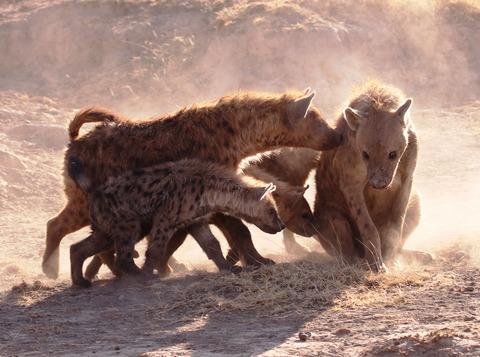当前位置:
X-MOL 学术
›
Funct. Ecol.
›
论文详情
Our official English website, www.x-mol.net, welcomes your
feedback! (Note: you will need to create a separate account there.)
The interplay between social rank, physiological constraints and investment in courtship in male spotted hyenas
Functional Ecology ( IF 4.6 ) Pub Date : 2020-12-14 , DOI: 10.1111/1365-2435.13733 Eve Davidian 1 , Bettina Wachter 1 , Ilja Heckmann 1 , Martin Dehnhard 2 , Heribert Hofer 1, 3, 4 , Oliver P. Höner 1
中文翻译:

男性斑鬣狗的社会地位,生理限制和求爱投资之间的相互作用
更新日期:2020-12-14
Functional Ecology ( IF 4.6 ) Pub Date : 2020-12-14 , DOI: 10.1111/1365-2435.13733 Eve Davidian 1 , Bettina Wachter 1 , Ilja Heckmann 1 , Martin Dehnhard 2 , Heribert Hofer 1, 3, 4 , Oliver P. Höner 1
Affiliation

|
- In many animal societies, dominant males have a higher reproductive success than subordinate males. The proximate mechanisms by which social rank influences reproductive success are poorly understood. One prominent hypothesis posits that rank‐related male attributes of attractiveness and fighting ability are the main mediators of reproductive skew. Yet, empirical evidence in support of this hypothesis is limited. An alternative hypothesis emphasises the inherent social dimension of dominance relationships and posits that the relationship between male social rank and reproductive success is mediated by the physiological costs of male–male competition. This has not been tested in systems in which the two hypotheses can be disentangled.
- We investigated the interplay between male social rank, physiological costs and male investment in social and sexual activities. We used measurements of faecal glucocorticoid metabolite concentrations (fGMC) as biomarkers of physiological costs and long‐term behavioural data of 319 males in free‐ranging spotted hyenas Crocuta crocuta, a species in which male access to females and reproductive success do not depend on physical attributes.
- When males courted females and interacted with male competitors, low‐ranking males had higher fGMC than high‐ranking males. In contrast, fGMC did not vary with social rank when males were alone or when they courted females and competitors were absent. Low‐ranking males minimised their exposure to physiologically costly intrasexual competition; they spent more time alone and less time engaging in social and sexual activities than did high‐ranking males. They also invested less than high‐ranking males in courting the most contested and highest‐quality females.
- Our findings demonstrate that the physiological costs of intrasexual competition in male spotted hyenas vary with social rank and shape behavioural trade‐offs between the allocation of time and physiological resources to social integration, reproduction and self‐maintenance. Our study suggests that physiological and social constraints play a pivotal role in the emergence of rank‐related male reproductive success. The study provides insights into how the social organisation and breeding system shape physiological constraints and patterns of reproductive skew within and between species.
中文翻译:

男性斑鬣狗的社会地位,生理限制和求爱投资之间的相互作用
- 在许多动物社会中,优势雄性比次级雄性具有更高的繁殖成功率。人们对社会等级影响生殖成功的最接近的机制知之甚少。一个重要的假设认为,与等级相关的男性吸引力和战斗力是繁殖偏斜的主要媒介。但是,支持该假设的经验证据有限。另一种假说强调了优势关系的内在社会维度,并假设男性社会地位与生殖成功之间的关系是由男性与男性竞争的生理成本所介导的。在两个假设都可以解开的系统中,尚未对此进行过测试。
- 我们调查了男性社会地位,生理成本以及男性在社交和性活动中的投资之间的相互作用。我们使用粪便中糖皮质激素代谢物浓度(fGMC)的测量作为散点斑鬣狗(Crocuta crocuta)中319名雄性的生理成本和长期行为数据的生物标志物,该物种中雄性获得雌性和繁殖成功与否取决于体质属性。
- 当男性向女性求爱并与男性竞争者互动时,排名较低的男性的fGMC高于排名较高的男性。相反,当男性独自一人或向女性求偶而没有竞争者时,fGMC不会随社会等级的变化而变化。低等级的男性将其遭受生理上昂贵的性竞争的机会降到最低。与高级男性相比,他们独自度过的时间更多,参与社交和性活动的时间更少。在招募竞争最激烈,素质最高的女性方面,他们投入的资金也少于高级男性。
- 我们的研究结果表明,雄性斑鬣狗的内部竞争的生理成本随社会等级和在分配时间和生理资源以促进社会融合,繁殖和自我维持之间的行为权衡而变化。我们的研究表明,生理和社会限制因素在与等级相关的男性生殖成功的出现中起着举足轻重的作用。这项研究提供了有关社会组织和育种系统如何塑造物种内部和物种之间的生理限制和生殖偏态模式的见解。











































 京公网安备 11010802027423号
京公网安备 11010802027423号